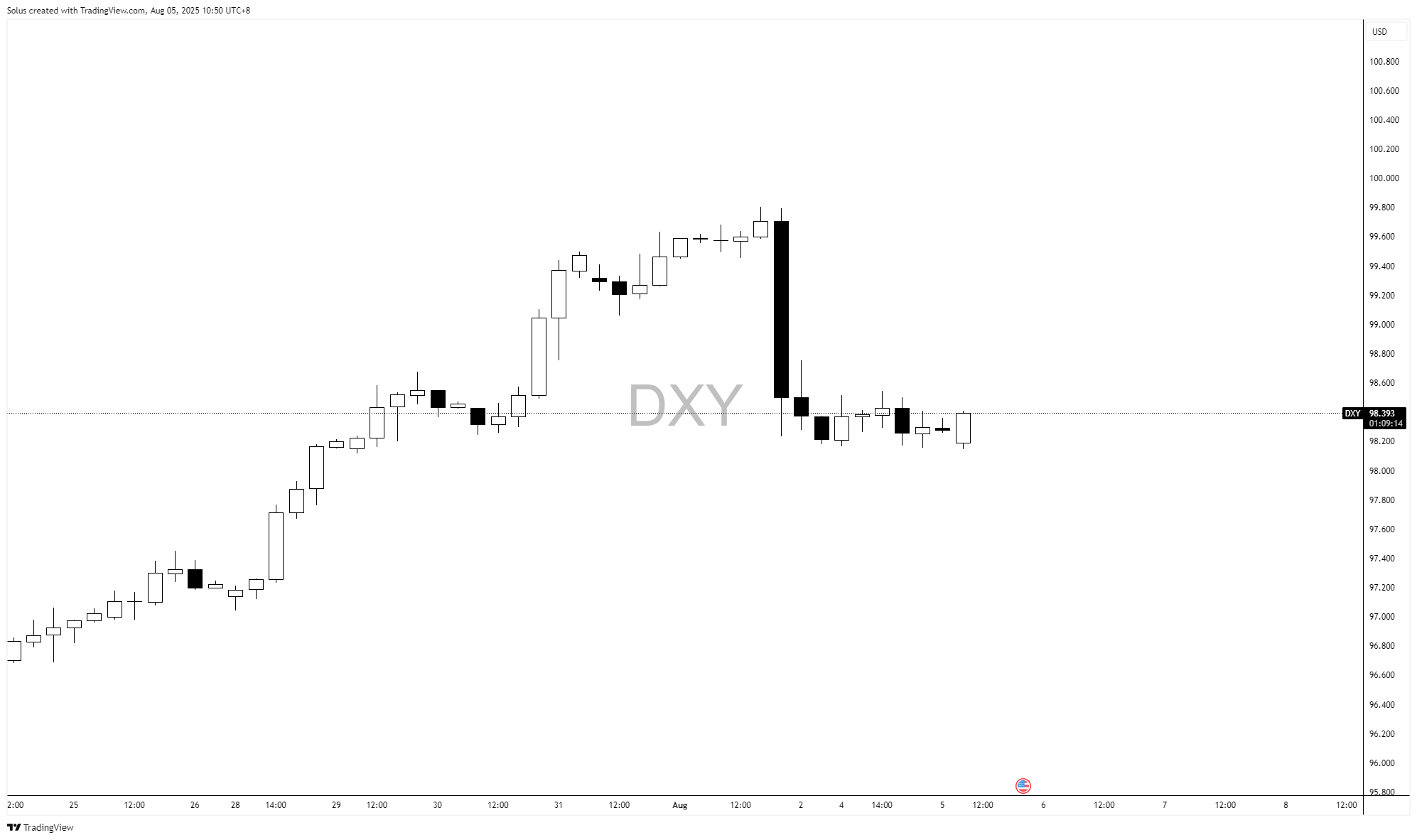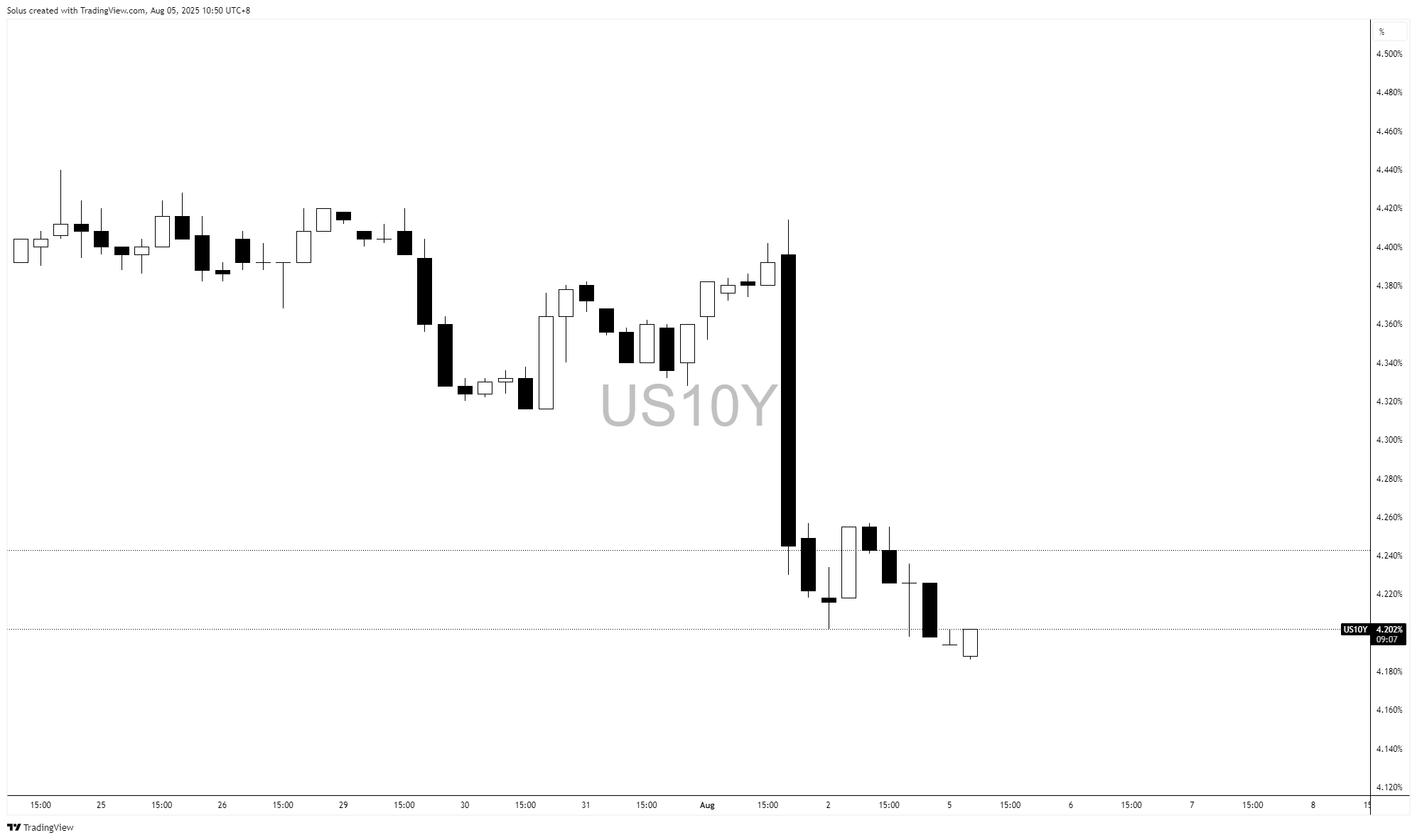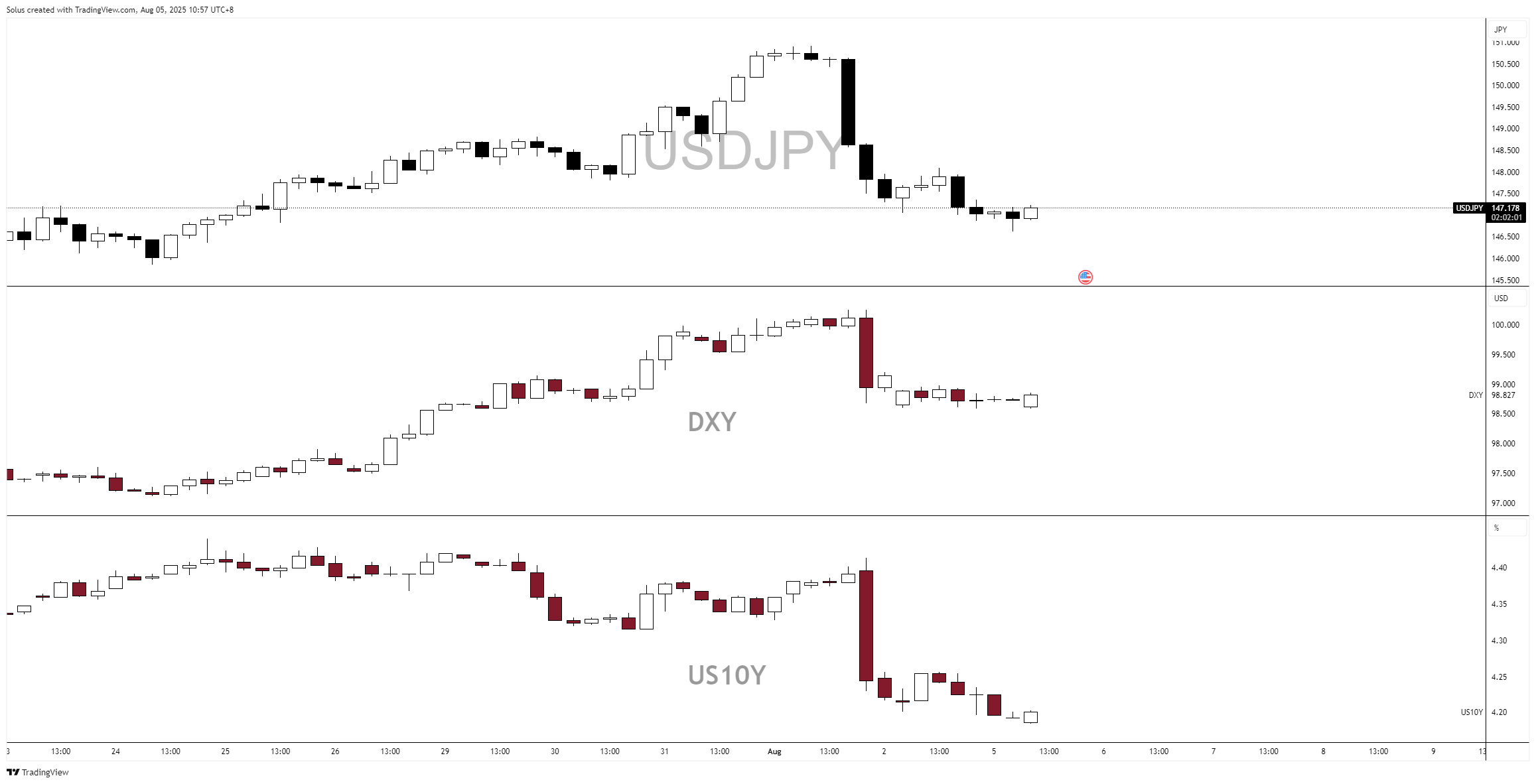USD/JPY: Correlation of DXY vs US10Y
2025-08-05 11:18:26
In our previous guide, USD/JPY: How to Trade the Fastest Moving Forex Pair with Precision, we laid out the roadmap for trading one of the most dynamic pairs in forex. From Tokyo session sweeps to yield-driven momentum bursts, USD/JPY revealed itself to be less about noise and more about narrative.
But there’s one question traders keep asking after mastering the basics:
Should I correlate USD/JPY with DXY or the U.S. 10-Year Yield?
Let’s put that question to rest once and for all.
Recap: Why USD/JPY Moves the Way It Does

As we covered previously, USD/JPY responds to:
- Interest rate differentials between the U.S. and Japan
- Risk-on vs risk-off sentiment
- Verbal or actual BoJ interventions
- Macro events like CPI, NFP, or Fed decisions
But there’s one force that consistently moves USD/JPY with almost surgical precision: the U.S. 10-Year Treasury Yield (US10Y).
Why Most Traders Default to DXY - and Why That’s a Problem

It’s natural to use the Dollar Index as a guide. After all, it tracks the strength of the U.S. dollar. But here’s the catch most don’t realize:
- DXY is made up of six currencies
- The euro makes up 57.6% of the index
- The yen accounts for only 13.6%
That means DXY mostly reflects EUR/USD behavior. So if EUR is rising due to European data, DXY might fall, even while USD/JPY is rising.

You end up following the wrong signal, missing setups, or worse, taking the opposite side.
US10Y: The Real Driver of USD/JPY

USD/JPY is incredibly sensitive to interest rate differentials, specifically the gap between U.S. and Japanese bond yields.
Unlike DXY, the U.S. 10-Year Treasury Yield (US10Y) offers a direct lens into what’s moving USD/JPY. Here's why:
- USD/JPY is highly sensitive to interest rate differentials
- US10Y reflects inflation, growth, and Fed expectations
- When yields rise, investors buy dollars, pushing USD/JPY higher
- When yields fall, money flows to safer assets like the yen, and USD/JPY drops
This isn’t just correlation - it’s mechanical causation.
Comparing Bananas to Apples
Tracking USD/JPY with DXY is like watching the euro to forecast the yen.
It can work in short bursts, but over time, it leads you down the wrong path.
Tracking yields, on the other hand, puts your finger on the real market lever.
When to Use DXY vs US10Y
| Situation | Use DXY | Use US10Y |
|---|---|---|
| Trading EUR/USD or GBP/USD | ✅ | |
| Trading USD/JPY intraday or swing | ✅ | |
| Assessing broad USD strength | ✅ | ✅ |
| Identifying misalignment or divergence | ✅ | ✅ |
Use DXY for sentiment, but use US10Y for precision when trading USD/JPY.
How to Overlay It All in One Chart

- Open USD/JPY on TradingView
- Add US10Y using the “Compare” feature
- Add DXY as a second overlay
- Watch how USD/JPY shadows yields, not the index
- During CPI, NFP, or Fed announcements, observe which leads and which lags
The pattern becomes clear. Yields lead. USD/JPY follows. DXY reacts.
Real-Life Analogy: The Wrong Forecast

Using DXY to trade USD/JPY is like dressing for the weather based on someone else's city.
Using US10Y is like stepping outside and feeling the air yourself. It’s live, local, and accurate.
Challenge for the Week

This week, before entering any USD/JPY trade:
- Check the US10Y chart
- Note whether yields are rising, falling, or ranging
- Align your directional bias accordingly
- Only take setups when your technical entry model (MSS, FVG, OB) aligns with the bond market’s message
Then compare what DXY is doing. You’ll spot the difference, and gain the edge.
Start Practicing with Confidence - Risk-Free!
Open a free demo account today and experience institutional-grade spreads, lightning-fast execution, and all the tools you need to grow as a trader.
- Trade forex, indices, gold, and more
- Access ACY, MT4, MT5, & Copy Trading Platforms
- Practice with zero risk
It’s time to go from theory to execution - risk-free.
Create an Account. Start Your Free Demo!
Check Out My Contents:
Strategies That You Can Use
How To Trade & Scalp Indices at the Open Using Smart Money Concepts (SMC)
How to Trade Breakouts Effectively in Day Trading with Smart Money Concepts
Complete Step-by-Step Guide to Day Trading Gold (XAU/USD) with Smart Money Concepts (SMC)
The Power of Multi-Timeframe Analysis in Smart Money Concepts (SMC)
Forex Trading Strategy for Beginners
Mastering Candlestick Pattern Analysis with the SMC Strategy for Day Trading
Mastering Risk Management: Stop Loss, Take Profit, and Position Sizing
How to Use Fibonacci to Set Targets & Stops (Complete Guide)
RSI Divergence Trading Strategy for Gold: How to Identify and Trade Trend Reversals
Stochastics Trading Secrets: How to Time Entries in Trending Markets using Stochastics
Gold Trading Stochastics Strategy: How to Trade Gold with 2R–3R Targets
RSI Hidden Divergence Explained: How to Spot Trend Continuations Like a Pro
Indicators / Tools for Trading
The Ultimate Guide to Risk Management in Trading – A Complete Compilation for 2025
Moving Averages Trading Strategy Playbook
How to Think Like a Price Action Trader
Mastering Fibonacci Trading Psychology – Trusting the Levels, Managing the Mind
How To Trade News
Why Smart Money Concepts Work in News-Driven Markets - CPI, NFP, and More
How to Trade NFP Using Smart Money Concepts (SMC)-A Proven Strategy for Forex Traders
How to Trade CPI Like Smart Money - A Step-by-Step Guide Using SMC
Learn How to Trade US Indices
How to Start Trading Indices and Get into the Stock Market with Low Capital (2025 Guide)
Best Indices to Trade for Day Traders | NASDAQ, S&P 500, DAX + Best Times to Trade Them
How To Trade & Scalp Indices at the Open Using Smart Money Concepts (SMC)
NAS100 - How to Trade the Nasdaq Like a Pro (Smart Money Edition)
How to Trade CPI Like Smart Money - A Step-by-Step Guide Using SMC
Why Smart Money Concepts Work in News-Driven Markets - CPI, NFP, and More
How to Start Trading Gold
How to Swing Trade Gold (XAU/USD) Using Smart Money Concepts: A Simple Guide for Traders
Complete Step-by-Step Guide to Day Trading Gold (XAU/USD) with Smart Money Concepts (SMC)
The Ultimate Guide to Backtesting and Trading Gold (XAU/USD) Using Smart Money Concepts (SMC)
Why Gold Remains the Ultimate Security in a Shifting World
How to Trade Japanese Candlesticks
How to Trade Candlestick Patterns with High Probability: A Complete Guide for Beginners
The Top Japanese Candlestick Guide: What is an Engulfing Pattern and How to Trade It?
Piercing Pattern Candlestick Explained: How to Trade It - Step-By-Step Guide
Morning & Evening Star Candlestick Patterns – How to Trade Market Reversals with Confidence
How to Start Day Trading
5 Steps to Start Day Trading: A Strategic Guide for Beginners
8 Steps How to Start Forex Day Trading in 2025: A Beginner’s Step-by-Step Guide
3 Steps to Build a Trading Routine for Consistency and Discipline - Day Trading Edition
The Ultimate Guide to Understanding Market Trends and Price Action
Trading with Momentum: The Best Trading Session to Trade Forex, Gold and Indices
Learn how to navigate yourself in times of turmoil
How to Identify Risk-On and Risk-Off Market Sentiment: A Complete Trader’s Guide
How to Trade Risk-On and Risk-Off Sentiment - With Technical Confirmation
The Ultimate Guide to Understanding Market Trends and Price Action
Want to learn how to trade like the Smart Money?
Why Smart Money Concepts Work: The Truth Behind Liquidity and Price Action
Mastering the Market with Smart Money Concepts: 5 Strategic Approaches
Mastering Candlestick Pattern Analysis with the SMC Strategy for Day Trading
Understanding Liquidity Sweep: How Smart Money Trades Liquidity Zones in Forex, Gold, US Indices
The SMC Playbook Series Part 4: How to Confirm Trend Reversal & Direction using SMC
The SMC Playbook Series Part 5: The Power of Multi-Timeframe Analysis in Smart Money Concepts (SMC)
Fair Value Gaps Explained: How Smart Money Leaves Footprints in the Market
The Best Time to Use Smart Money Concepts (SMC): Why Timing Is Everything in Trading SMC
How to Trade the London Session Using Smart Money Concepts (SMC)
Trading Psychology and Continuous Improvement Contents
The Mental Game of Execution - Debunking the Common Trading Psychology
5 Steps to Backtest a Trading Strategy with AI: A Step-by-Step Guide
Managing Trading Losses: Why You Can Be Wrong and Still Win Big in Trading
The Hidden Threat in Trading: How Performance Anxiety Sabotages Your Edge
Why You Fail in Trading: You Don’t Have Enough Capital to Survive
Why 90% of Retail Traders Fail Even with Profitable Trading Strategies
The Top 10 Best Trading Books That Changed My Mindset, Strategy & Performance
Discovering Your Trader Profile: What Kind of Trader Are You?
Follow me for more daily market insights!
Jasper Osita - LinkedIn - FXStreet - YouTube
This content may have been written by a third party. ACY makes no representation or warranty and assumes no liability as to the accuracy or completeness of the information provided, nor any loss arising from any investment based on a recommendation, forecast or other information supplies by any third-party. This content is information only, and does not constitute financial, investment or other advice on which you can rely.
Try These Next
4 Powerful Tactics to Overcome the Most Costly Forex Mistakes
How to Master MT4 & MT5 - Tips and Tricks for Traders
The Importance of Fundamental Analysis in Forex Trading
Forex Leverage Explained: Mastering Forex Leverage in Trading & Controlling Margin
The Importance of Liquidity in Forex: A Beginner's Guide
Close All Metatrader Script: Maximise Your Trading Efficiency and Reduce Stress
Best Currency Pairs To Trade in 2025
Forex Trading Hours: Finding the Best Times to Trade FX
MetaTrader Expert Advisor - The Benefits of Algorithmic Trading and Forex EAs
Top 5 Candlestick Trading Formations Every Trader Must Know









